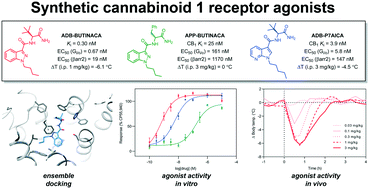Structure–activity relationships of valine, tert-leucine, and phenylalanine amino acid-derived synthetic cannabinoid receptor agonists related to ADB-BUTINACA, APP-BUTINACA, and ADB-P7AICA†
Abstract
Synthetic cannabinoid receptor agonists (SCRAs) remain one the most prevalent classes of new psychoactive substances (NPS) worldwide, and examples are generally poorly characterised at the time of first detection. We have synthesised a systematic library of amino acid-derived indole-, indazole-, and 7-azaindole-3-carboxamides related to recently detected drugs ADB-BUTINACA, APP-BUTINACA and ADB-P7AICA, and characterised these ligands for in vitro binding and agonist activity at cannabinoid receptor subtypes 1 and 2 (CB1 and CB2), and in vivo cannabimimetic activity. All compounds showed high affinity for CB1 (Ki 0.299–538 nM) and most at CB2 (Ki = 0.912–2190 nM), and most functioned as high efficacy agonists of CB1 and CB2 in a fluorescence-based membrane potential assay and a βarr2 recruitment assay (NanoBiT®), with some compounds being partial agonists in the NanoBiT® assay. Key structure–activity relationships (SARs) were identified for CB1/CB2 binding and CB1/CB2 functional activities; (1) for a given core, affinities and potencies for tert-leucinamides (ADB-) > valinamides (AB-) ≫ phenylalaninamides (APP-); (2) for a given amino acid side-chain, affinities and potencies for indazoles > indoles ≫ 7-azaindoles. Radiobiotelemetric evaluation of ADB-BUTINACA, APP-BUTINACA and ADB-P7AICA in mice demonstrated that ADB-BUTINACA and ADB-P7AICA were cannabimimetic at 0.1 mg kg−1 and 10 mg kg−1 doses, respectively, as measured by pronounced decreases in core body temperature. APP-BUTINACA failed to elicit any hypothermic response up to the maximally tested 10 mg kg−1 dose, yielding an in vivo potency ranking of ADB-BUTINACA > ADB-P7AICA > APP-BUTINACA.

- This article is part of the themed collection: Emerging Investigators


 Please wait while we load your content...
Please wait while we load your content...